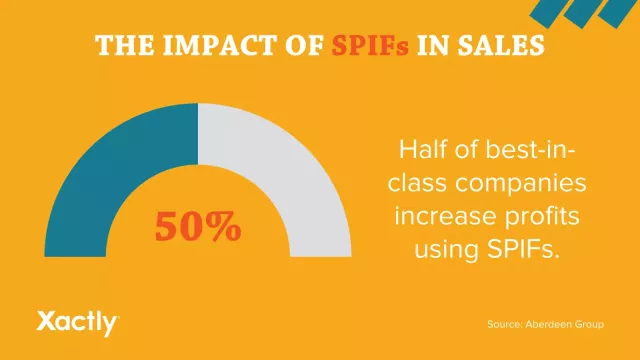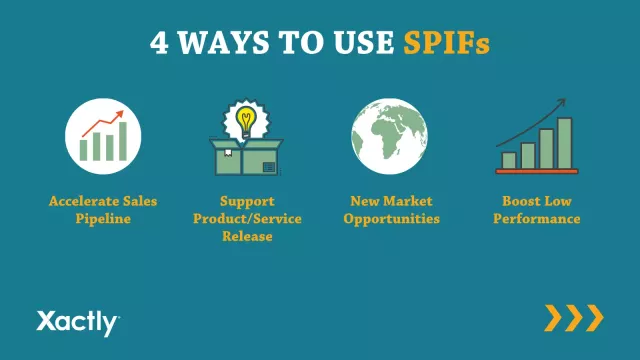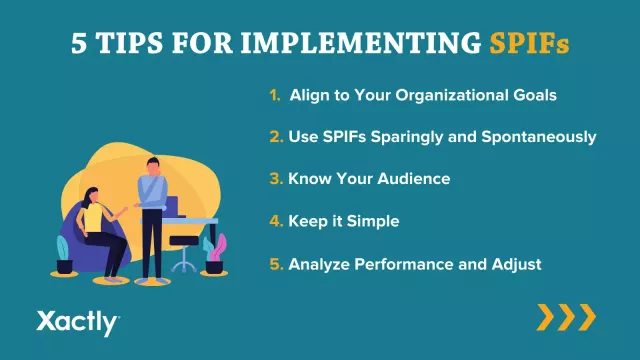
The Impact of SPIF in Sales
A sales SPIF, also known as a special performance incentive fund, is a short-term incentive used to drive sales of a designated product or service. SPIFs are often considered in compensation planning but are not always mapped out ahead of time. Rather, they are often spontaneous incentives used to boost performance over a short period.
It’s probably no coincidence that the verb spiff means to dress or spruce up something and give it a little extra pizzazz. In the same way, SPIFs are meant to motivate reps to shift their focus slightly to emphasize certain deal structures, products, or services.
So why use short-term incentive plans when you already have an overarching incentive compensation plan? Because they work. Research from the Aberdeen Group shows that more than 50 percent of best-in-class companies drove increased profits through SPIFs.
So, to help you get the most out of this short-term incentive, here is everything you need to know about implementing sales SPIFs.
When to Use Sales SPIFs
When implementing a Sales Performance Incentive Fund (SPIF), it’s common to focus on a specific product or service. Sometimes the product is chosen because there is momentum building in sales, increasing opportunities in the market, or because sales are not where they should be to meet organizational goals. A new product launch or the need to complete sales within a specified time period could also call for a SPIF.
However, it’s important to remember that SPIFs are an additional incentive and should not replace your overarching sales compensation plan. Rather, they should supplement your existing plan to drive short-term performance.
Here are four ways you can use a SPIF to drive and increase sales performance:
1. Accelerate Sales Pipeline
There are several reasons deals can stall in the pipeline—whether it’s a slower time of business or early in the quarter. SPIFs can be helpful to motivate reps to push deals down the sales funnel and progress deals.
However, if you’re noticing a trend in your pipeline of deals stalling or falling off, you may need to dive deeper into your data to see if there is a need for additional coaching or training (Intelligent Forecasting software can help with that).
2. Support a Product or Service Release
For new products or services, it's important for organizations to create momentum for a successful launch. SPIFs can be helpful to put the new offerings at the top of sales reps' minds when they are assessing new prospects or looking to up-sell with current customers.
3. Take Advantage of New Market Opportunities
Similar to new product and service launches, SPIFs help companies take advantage of upcoming opportunities. Often, this means moving into a new market or industry that hasn't yet been tapped by competitors. A SPIF will encourage reps to jump on new leads and help establish the company as the first on the map in a new industry.
4. Boost Low Performance
Unfortunately, Sales SPIFs don't always accompany new releases or other positive scenarios. Sometimes they must be implemented to boost performance when sales numbers are low. SPIFs can boost sales performance by pushing highly-motivating short-term incentives into the existing sales compensation plan to ensure goals are met.
If you’re noticing a trend of poor performance across your sales team, it could be an indication that your overarching incentive plan isn’t driving the right sales behaviors. In that case, a SPIF may not be your best option, and you may want to take a deeper look at your compensation.
5 Tips for Implementing Sales SPIFs
SPIFs come in many shapes and sizes, including fixed-amount spot bonuses, double club credit, or double quota retirement. They can also take the form of non-cash incentives.
When spiffing up your incentive plan with a sales SPIF, keep these five tips in mind:
1. Align to Your Organizational Goals
The first thing to do when planning a SPIF is to consider your short-term and long-term goals. What is the overarching initiative you’re wanting to support? And in the short term, are you aiming to boost revenue, units sold, sales leads, or order size?
Aligning to your larger goals will help you develop sales SPIFs that drive the behaviors necessary to meet your sales targets. This is true for both SPIFs and your incentive compensation plans.
2. Use SPIFs Sparingly and Spontaneously
Timing plays an important role in the success of your SPIF success. These incentives are designed to boost sales in the short-term. Therefore, they shouldn't be used over long periods of time to drive performance. Based on historical performance data, you can find the right balance between incentive value (amount of money offered) and the amount of time needed to get on track to hit goals.
In addition, SPIFs that come at the same time every month or year become routine and don't work as effectively to motivate sales teams. When reps come to expect SPIFs at the end of each quarter or end of the year, the incentives can be taken advantage of. Keep your plan “gameable” by introducing SPIFs sparingly, so that sellers aren’t expecting them. As a good rule of thumb, you should have no more than eight or 12 SPIFs in one year.
3. Know Your Audience
One of the greatest benefits of short-term incentives is that they can be easily tailored to individuals and groups. Use your data to determine what kind of SPIFs have worked in the past and which are likely to work in the future. Then you can use incentive compensation management software to model out how different SPIFs might perform as part of your overall sales compensation plan.
4. Keep it Simple
SPIFs, like overarching sales compensation plans, should aim for simplicity. When performance incentives are simple, they lay out the expectations for sales reps clearly and ensure compensation administration execution is easy. At the most basic level, sales reps should understand that if they sell X, they will be rewarded with Y.
5. Analyze the Outcome & Adjust
For any compensation put before sales teams, it's important to analyze the performance and effectiveness of the incentives. The same is true for SPIFs. Compare the results to your predicted outcome, and decide if you like what you see.
You want to give enough time to see performance trends, which will vary based on your sales cycle. The important thing is to not set it and forget it. You need to analyze sales SPIF performance, and if it isn’t driving the desired behavior, use data to figure out why. Then, tweak your plan and do it all over again.
Unleashing Performance Potential
One of the many advantages of using SPIFs is that they can be used to reach any specific goal—no matter how large or small. And as part of your larger compensation plan, they can be the tool you need to hit your targets.
Discover additional types of incentives and ways you can increase sales performance in the "Complete Guide to Sales Team Compensation."







